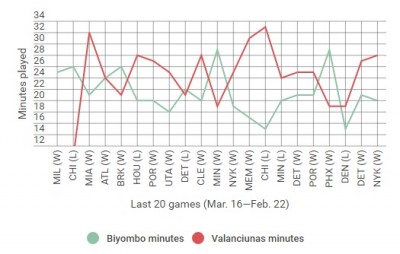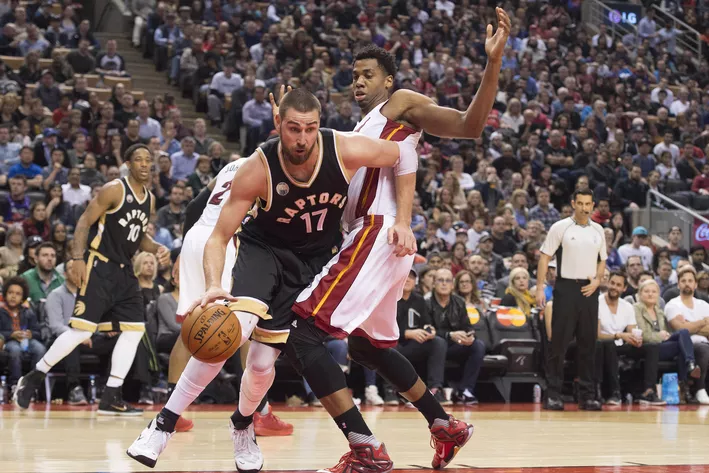Now that we’re nearly 70 games into the 2016 NBA season, we have a relatively clear idea of what exactly the Toronto Raptors are and what exactly they’re not. We know with some certainty, for example, that the Raptors are an explosive team on both ends of the floor, but that they’re not as consistent as other top teams on a quarter-to-quarter and game-to-game basis. Still, the results are there. The team’s 45-21 on the season, just two games behind the first-seeded Cleveland Cavaliers.
But few fans are, shall we say, comfortable with the Raptors. They do have a few glaring weaknesses, some of which cannot be rectified and others which can be but only in the offseason. One of those weaknesses is the power forward situation. Luis Scola continues to start ahead of Patrick Patterson (and now, Jason Thompson, too), despite being inferior of Patterson as mostly everything. But while much has been made of the Raptors’ predicament at power forward, their situation at center is just as interesting, though for entirely different reasons.
Jonas Valanciunas and Bismack Biyombo essentially split the minutes at center — Valanciunas averages 25.9 minutes per game and Biyombo averages 22.3 — and the two have yet to spend a single minute on the floor together. Yes, Valanciunas and Biyombo have played zero minutes together this season. They’re the only Raptors duo to have absolutely no minutes together this season, too. Sure, they’re both centers and playing them together regularly wouldn’t be wise in today’s pace-and-space NBA, but I can’t lie, this still surprised me. Even Bruno Caboclo and James Johnson have played a single minute together.
You can see this in the chart below:

Raptors head coach Dwane Casey’s held both centers accountable for their play, and rewards them with minutes when things go well. Check out how the peaks and valleys align in the above graph. When Valanciunas plays well, he receives more of the minutes. When Biyombo plays well, he gets the bulk of the minutes.
It’s a bit deeper than that, though.
It’s no secret that Valanciunas and Biyombo have complementary play styles. Valanciunas is a lumbering, old school big man with a soft touch around the rim and a jumper out to 15 feet. His defense and consistency leave much to be desired, though he’s gradually improved in both areas. Biyombo’s more your grit-and-grind, no-skills-to-speak-of-whatsoever-but-plays-his-ass-off big with terrific length and athleticism that help him lock down the paint and play effective pick-and-roll defense. It’s his offense that is basically nonexistent, although to his credit, he too is addressing his weaknesses.
Albeit at a slow pace.
But let’s be honest: any progress is good progress with these guys.
Still, this stark difference in play styles affords Casey the luxury of playing to the Raptors’ needs rather than with a strict rotation. When Kyle Lowry and DeMar DeRozan are struggling to score, Casey can throw Valanciunas in to force opponents to adjust their defensive schemes. When opponents are getting to the rim with ease (an increasingly common occurrence, these days) and exploiting the pick and roll, he can play Biyombo to anchor the defense. It’s this versatility up front that should pay huge dividends for the Raptors in the playoffs.
Just how different are they, statistically? Valanciunas’ offensive rating of 109.6 is bested only by Patrick Patterson (and Jason Thompson, I guess, though his sample size is tiny), whereas Biyombo’s rating of 104.9 is in the bottom half of the roster. Conversely, Biyombo’s defensive rating of 99.3 is the best of any Raptor not named Cory Joseph, while Valanciunas’ mark of 107.3 is the worst of any Raptor in the normal rotation. Only Anthony Bennett, Thompson and Caboclo have been worse.
If you were to look at their respective net ratings, you might be inclined to label Biyombo the more useful player, and to some extent you’d be right. However, that’s reductive of what’s actually happening and how the two centers need each other for the Raptors to truly thrive; it’s their ability to account for each other’s weaknesses that makes them special.
I suppose an argument could be made for Biyombo to start over Valanciunas, which could grant the bench unit a much-needed injection of offense while adding a defensive anchor to the starting lineup at the same time. But even that’s misguided. Much like the argument against changing the power forward rotation, if it ain’t broke, don’t try to fix it. The Raptors got to their current record of 45-21 with things the way they are, and give Casey credit — he’s managed his personnel exceptionally well all season. The Raptors have overachieved in spite of a handful of injuries to key players. In other words, Casey is smarter at basketball stuffs than you and I.
If Casey is to switch things up, it might happen in the playoffs. Maybe the Raptors pull the Indiana Pacers in the first round, and Casey decides Biyombo’s defense on Myles Turner is more valuable than Valanciunas’ offense. Should the Raptors run into a healthy Chicago Bulls team, it’s possible Casey employs the unseen Valanciunas-Biyombo lineup against the Bulls’ Pau Gasol and Taj Gibson. Or maybe they play the Detroit Pistons, and Casey decides to keep Valanciunas in to wear down Andre Drummond. Not many teams have options in the frontcourt like the Raptors do.
And should the Raps face off against the Cleveland Cavaliers in the Eastern Conference Finals, you know Casey’s going to switch it up from game to game. That quartet of Kevin Love, Tristan Thompson, Channing Frye, and Timofey Mozgov is no joke.
Unfortunately, the frontcourt tandem of Valanciunas and Biyombo might not exist past this season. Biyombo can decline his player option for next season and enter free agency in July, putting the Raptors in tricky situation: they might be able to afford him depending on what other moves they make (most importantly, whatever they do to keep/mitigate the loss of DeRozan), but other teams have noticed his improved play, too. And in a league where good defensive centers have become increasingly rare, Biyombo’s likely to get quite the pay raise this summer, especially with the exploding cap. I’ve seen numbers as high as $10 million per year thrown around on Twitter, though the reality is probably closer to $6-8 million.
But for now, the Raptors are living large. Few teams share the depth they have at any position, let alone at center. Casey’s use of Valanciunas and Biyombo has been nothing short of masterful, and we’re going to see even more tricks and strategies in April, where teams adjust on a game-by-game basis. After that, we can only hope that Masai Ujiri’s salary cap gymnastics and relationship with Biyombo help the Raptors re-sign him.
Because this pairing? It works, and it works well. It’d be a shame to break it up.



